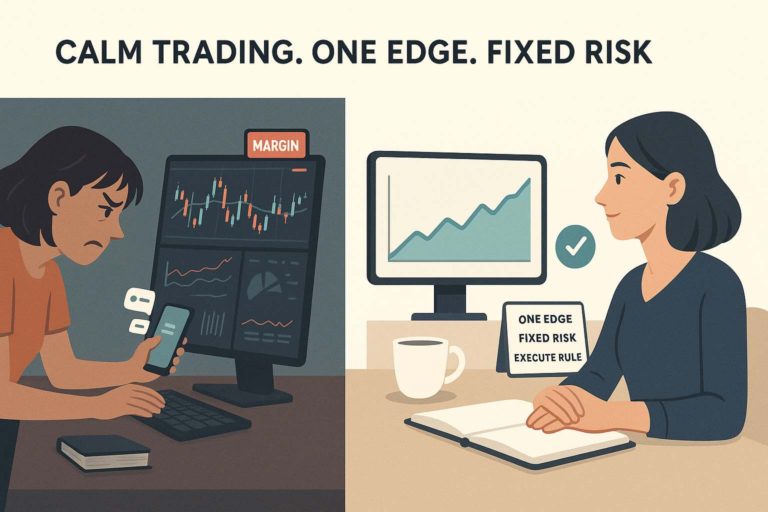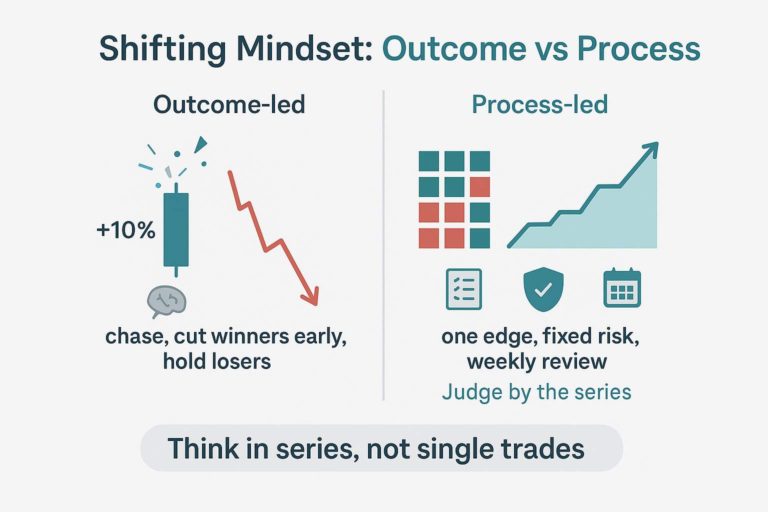Overview: Lorette used to research endlessly, watch screens all day, and overthink every trade. But when she moved to using a mechanical edge, with fixed risk and rule-based execution, she has since traded calmly, has followed alerts without negotiation, and has judged results by a series of trades, rather than relying on a single outcome.
This case study shows exactly what changed for Lorette: habits, rules, and mindset.

Lorette loved trading but hated the stress. She didn’t like juggling shift work, margin nerves, and endless research loops. She also didn’t want to always check her phone, second-guess exits, and chase the “right” stock. What she wanted wasn’t more information; she wanted a simple way to trade clearly.
This is why she switched to one mechanical edge with fixed risk, stopped negotiating with signals, and built a routine that she can run even on busy days, slow days, and everything in between.
Who is Lorette, and what did trading feel like before?
Lorette has an engineering background and now works shift work driving trains. She has been enjoying the markets and has even been funding two investment property deposits from trading profits. But it has always felt like hard work:
“I was constantly on my phone… on margin at one stage… very nerve-wracking on bad days.”
“Without experience, you end up over-analysing in circles. It’s exhausting.”
She tried the classic dividend/DRP approach, held names too long, and admitted that she sometimes sold winners too early and held losers too long. In short: success came in bursts, then give-back. Lots of effort, low peace.
Takeaway: Early wins don’t equal a durable process. Without a single edge and fixed risk, stress fills the gaps.
What problem was she really trying to solve?
Not “how to pick the next stock,” but how to make trading calmer and sustainable. She wants to have:
- Less screen time and second-guessing
- No more margin anxiety
- A way to execute without overthinking
- Habits she could carry into life outside markets
Takeaway: Most traders don’t need more information; they need one repeatable process they can trust.
What has changed after joining SWS and LTTP?
Lorette heard about Share Wealth Systems through a trusted colleague and has since completed our Learn To Trade Properly (LTTP) program. Her words:
“Reading the books you recommended and listening to you speak, trusting the process over a longer period, gave me calm. Sometimes I don’t even look at my portfolio…I know it’s doing what it has to do.”
She moved from ad-hoc decisions to a mechanical system:
- One tested edge with predefined risk per position
- Entries, stops, and exits are set in advance
- No mid-trade edits: “The exit fires because the rule says so.”
She also began journaling and weekly reviews. The focus shifted from predicting to executing.
Takeaway: Calm shows up when rules replace negotiation.
How did she handle shift work and still execute consistently?
Lorette has fitted the scan cadence into her schedule. If a valid alert hit while she’s sleeping, she acts next session:
“This morning I had the sell alert. I placed the order when I woke up. I wasn’t fussed; a small loss is fine. Over time, it comes back.”
No chasing, no “catching up,” no rewriting the plan. She has learned to accept predefined loss and keep moving.
Takeaway: Consistency doesn’t require looking all-day at the screens; it requires keeping routines.
Which habits actually made the difference?
Lorette has leaned into habit-building. She has consistently talked about our reading list and how it has spilled into her life: new routines, better decisions, less noise. She now tracks:
- WR/PR/expectancy (the edge, not the last trade)
- Adherence (did she follow the rule?)
- Drawdown (staying safe while compounding)
She also uses a simple pre-trade checklist and a “no negotiation” card at the desk.
Takeaway: Habits are the delivery system for your edge.
What mindset shift did she experience?

This is pure trading psychology in action:
“It’s almost a cliché… let profits run, cut losses, but most people do the opposite.”
“I don’t like losing… so learning to accept a loss as part of the game was big for me.”
She stopped trying to “make it back” quickly. She stopped selling winners at +10% just to “recycle” into another quick +10%. Instead, she let the system decide.
Takeaway: Professionals think in a series of trades; amateurs grade each trade as a verdict on themselves.
What results can you reasonably expect from this approach?
Lorette doesn’t pitch miracle numbers. Instead, she reports lower stress, cleaner execution, and confidence to add capital:
“I’ve started adding to my investing because I began at the bare minimum. Over the next three years, I want to grow that, accepting the good and the bad along the way.”
This is how compounding actually happens: protection first, adherence second, size later.
Takeaway: Slow is smooth. Smooth is fast.
How does Lorette’s story compare to our other members?
You’ll see the same pattern in other members’ journeys:
- Gavin H moved from 15 years of confusion to calm, rules-based execution. Read his story here: Transforming 15 Years of Trading Frustration into Consistent Profit.
- Phil F focused on becoming a calm trader, using the same rules + review rhythm: How Phil Learned to Be a Calm Trader
Takeaway: Different backgrounds, same fix: one edge, fixed risk, rule-based execution.
Summary: What did Lorette stop doing and start doing?
Stopped
- Checking the phone all day
- Moving stops to “give it room”
- Selling winners too early to “recycle gains”
- Over-researching and second-guessing
Started
- Acting on alerts without debate
- Accepting predefined losses
- Weekly WR/PR/expectancy review
- Building habits she can keep on shift work
Takeaway: You don’t need more indicators. You need fewer decisions.
What’s a simple 30-day plan you can copy?
- Set your risk unit (small enough to sleep at night).
- Print your rule card (entry, stop, exit).
- Start a journal (adherence + notes).
- Run the scan on a kept schedule (even if short).
- Place orders with fixed risk, no edits.
- First weekly review: WR, PR, expectancy, drawdown, adherence.
- Make one small process adjustment if needed.
- Repeat the loop. Aim for 20+ rule-clean trades.
- If adherence ≥ 90% and drawdown inside plan, maintain size; don’t scale yet.
Takeaway: Earn consistency first; size later.
Final Thoughts
The lesson from Lorette’s story is simple: one edge, fixed risk, rules you can keep. She has turned anxiety into a routine she can run around a busy, shifting schedule. That’s what professionals do. If you saw yourself in any part of her “before,” borrow her “after.”
Ready to trade with calm, rule-based confidence? We’ll help you set your risk unit, install the rule set, and build the weekly review rhythm. You’ll leave month one with a working process, not a mystery.
Frequently Asked Questions
Can I do this with shift work?
Yes. Lorette does. Fit the scan/placement to the schedule you can keep. Consistency beats screen time.
What if I hate taking losses?
That’s normal. What you can do is to use small, predefined risks and judge yourself by adherence, not P/L. Confidence follows compliance.
Do I need to understand every metric?
Start with the vital few: Win Rate, Profit Ratio, Expectancy, Drawdown, Adherence. Add depth later.
How fast will I feel calmer?
Often, within 1–2 weeks, once you stop negotiating mid-trade. Measurable consistency usually shows over 1–3 months as the series builds.
Where does trading psychology fit?
It’s everywhere: before the trade (checklist), during (no edits), after (review). The system reduces decision-fatigue so your psychology has less to sabotage.
